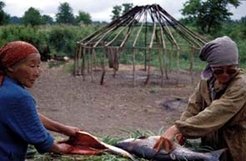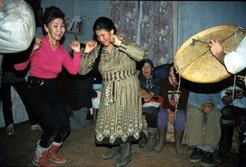Translocality and Symbols of Collective Identities in Native Communities in Kamchatka.
Background
My interest in Siberian anthropology arose initially to round off previous research in the circumpolar North, after earlier dissertation work on Saami economic history and postdoctoral studies on First Nations' ceremonialism in contemporary political contexts in the Canadian Pacific Northwest. The more intimate knowledge of two different - both inland and coastal - northern economies and cultures provided the background for my current interest in interactions between such groups; interactions, which have obviously always been crucial for the survival of native people in the Russian North.
The research and work with native communities on the Northwest Coast, in particular, had made me aware of issues and methods that later became relevant for my research in the Russian North and under my current project at the Max Planck Institute for Social Anthropology. In the late 1980s, land claim issues were a prominent theme in the Canadian Pacific Northwest and cultural traditions were increasingly being interpreted politically in the context of property relations to certain territories. For validating such claims, symbols of ethnicity had to be displayed and manipulated to meet current needs. This is nothing novel but clearly in line with how native peoples and groups in that region and elsewhere had presumably defined and dealt with property relations regarding their territories in the past (Kasten 1996). To a certain degree, native leaders were able to merge their traditional political and legal systems with those of the state in the courts.
From such experiences I acquired the understanding that investigating even tangible property relations - if studied from an anthropological perspective - must take into consideration the strategic use of symbols of collective identities. Such political interpretations of one's cultural tradition (or certain aspects of it) leads to its transformation into what can be perceived as cultural property of an individual or a certain group.
With the fall of the iron curtain, I have taken up the fascinating challenge of investigate such issues in the Russian North, particularly in the Russian Far East. I could thus situate my work in comparative North Pacific Rim research traditions after they were revived one hundred years after the Jesup Expedition first attempted such a comprehensive task. Living in similar natural environments, the native peoples of that area had developed similar economies and cultures and they have experienced similar forms of colonisation, although their more recent political histories of integration into foreign state systems had differed a great deal. To study the more recent specific postsocialist transformations in native communities against the background of general developments in the circumpolar North has become one of my primary goals since beginning my research in Kamchatka in 1993.
Current project
Building upon previous research with the Itelmen and Even groups living in western and central Kamchatka, in the last three years I widened and eventually focused my interest on property issues of Koryak groups in the northern parts of the peninsula. In the course of my fieldwork (3-5 months each year), a number of key questions turned out to be particularly relevant for the future viability of local economies - especially reindeer herding - and the persistence of indigenous communities of that area.
First, in the framework of ecological and environmental anthropology, the question arises, if private ownership or collective rights to reindeer or pasture and fishing sites, or combinations of both, can more likely put a halt to often uncontrolled resource use and progressive degradation of important natural resources, as often witnessed in postsocialist transitional times. Elders still remember the effectiveness of flexible regulations about the use of one's family territories, i.e. territories where the forefathers used to herd, to fish or to hunt - and for which their children had obtained the necessary specific ecological knowledge for their appropriate use.

Such traditional concepts and the mutual understandings of non-formalised agreements and respect of the territories of others are in sharp contrast to new indigenous legislation such as the obshchina model, which implies strict boundaries. Although promoted by native leaders as a way of protecting native lands against outsiders, such regulations for the privatisation of land have created a lot of irritation and earned harsh critique within the communities.

This is due not only for ecological reasons but because they may cause the break-up of social relationships which once tied local groups, using different and often distant complementary resources of a larger area, together. The latter becomes even more relevant in present times of collapsing socialist support systems and limited prospects for developing local or foreign markets.
"Translocality" perhaps most precisely describes some of the key concepts which many elders, i.e. those who are still connected to the land and care about it, expressed and which they would like to see revived and applied again. From their point of view, these would most likely guarantee the viability of their traditional economies and the social coherence of local communities. Beyond the debate on rights or titles to certain lands, the specific knowledge that goes along with the land in order to use it properly and in a sustainable way, is seen as particularly important to them. Thus, they are extremely concerned about adequate channels of transmission of endangered ecological knowledge to future generations.
Translocality and Symbols of Collective Identities in Native Communities in Kamchatka.
These economic and ecological themes, as well as political issues and the rebuilding of collective identities in the Russian North, were the focus of the international conference "Postsocialisms in the Russian North" that I organised at the Max Planck Institute for Social Anthropology in November 8-9, 2000 (Kasten, ed. 2002a).
Cultural property, i.e. the promotion (or creation) of symbols of collective identities or ethnicity in the process of claiming indigenous rights or entitlements, among others with respect to access or ownership to tangible property such as land, is the second prominent theme of my research. Native art and craft traditions, and especially dances, received already in Soviet times additional meaning because they received significant state support for propaganda reasons, for example through ethnic festivals and as part of the work in so-called agitkultbrigady (agitation-culture-brigades). Native performers have happily adapted such models offered by the state to their advantage, as this meant privileges such as travel, even to western countries even during the Soviet period. Today, native art and dance traditions continue and seem to gain even more traditional meaning within the local context for maintaining or strengthening family and group identities.

At the same time, already existing ways of commodification of such traditions have received new impetus while they become more privately organised. Following western models of promoting indigenous rights, they are also used by native leaders to underline internationally ethnic status and claims connected to it by means of displaying of what is perceived as the cultural property of the respective ethnic group.
The workshop "A World of Cultures: Culture as Property in Anthropological Perspective", organised by Deema Kaneff and myself that will be held July 1-2, 2002 at the Max Planck Institute for Social Anthropology will further explore such issues of cultural property in the Russian North and discuss them comparatively.
After my initial contribution at the first conference on the Jesup Expedition at the American Museum of Natural History in New York in 1997, a broader comparison of my findings on cultural property issues in Kamchatka and in the Canadian Pacific Northwest will be presented at a second meeting in Sapporo, Japan, in October 2002.
Associated projects
Some of these main topics of my research are part of collaborative projects with other academic institutions in Germany and in Kamchatka. These go back to the mid-1990s and were extended under the current program at the Max Planck Institute and some of them will continue into the future.
Several joint projects on ecological and environmental issues with researchers of the Kamchatka Institute of Ecology and Resource Management in Petropavlovsk-Kamchatski started during my former affiliation with the Free University in Berlin (Kasten/Dulchenko ed., 1996) and continue to date. Another co-authored monograph on the Even of the Bystrinski Rayon in Central Kamchatka will come out in May 2003 (in Russian).
Collaborative projects with native researchers at the Institute for Advanced Teachers Training in Palana and with the Kamchatka State Pedagogical University, supported by the Franckesche Stiftungen zu Halle and the UNESCO have resulted in a number of workshops in Kamchatka (Kasten, ed. 2002b) and the production of teaching materials for local schools (Dürr/Kasten/Khaloimova 2001). These activities are mostly concerned with the preservation of endangered languages and traditional knowledge. They exist in connection with a current project at the Museum of Ethnology in Berlin, funded by the Deutsche Forschungsgemeinschaft, which focuses on contextual variations in perfomative arts and material culture of Koryak groups in the northern parts of Kamchatka.


